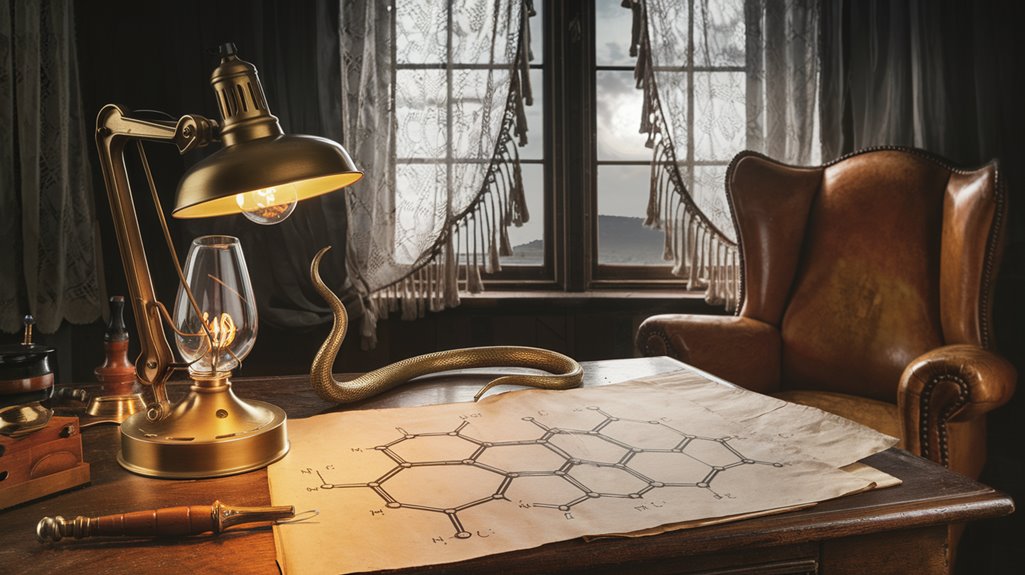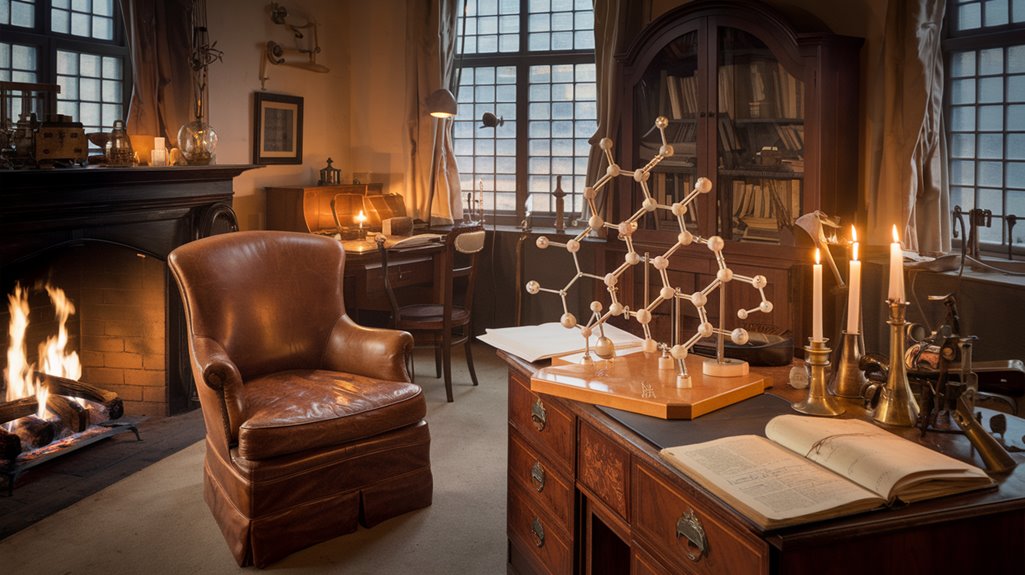A Scientist’s Dream That Led to a Major Chemistry Breakthrough
You've probably heard that many great discoveries come from unexpected places, but a snake eating its tail might be one of the strangest sources of scientific inspiration. When chemist August Kekulé dozed off one winter evening in 1861, he couldn't have known his dream would revolutionize organic chemistry. His subconscious vision solved a puzzle that had stumped scientists for years – the true structure of benzene – and what followed would change the field of chemistry forever.
The Early Life and Education of August Kekulé

Although initially drawn to architecture, August Kekulé's path took an unexpected turn that would reshape chemistry forever.
Born in 1829 to an upper-middle-class family in Darmstadt, his childhood influences included a natural aptitude for languages, drawing, and science.
His talent for sketching would influence his later ability to visually conceptualize complex chemical structures.
When you look at his early academic challenges, you'll find they weren't in mastering subjects but in choosing his path.
While studying architecture at the University of Giessen in 1847, Justus von Liebig's chemistry lectures captivated him, prompting him to switch fields.
After earning his doctorate in 1852, Kekulé's journey led him through Paris, Chur, and London, where he formed essential relationships with leading chemists like Charles Gerhardt and Alexander Williamson.
His exceptional memory and multilingual abilities would later prove invaluable in his groundbreaking research.
During his time in London, he worked under John Stenhouse where he first encountered organic chemistry, setting the stage for his future discoveries.
The Mysterious Dream of the Snake and Ring
How does a dream become one of science's most celebrated moments of inspiration?
In the winter of 1861-1862, you'd find August Kekulé dozing by his fireplace in Ghent, Belgium, wrestling with the puzzle of benzene's structure.
As he drifted into sleep, a vision emerged: atoms danced before his eyes, forming a snake that seized its own tail. His discovery was built upon an earlier dream that revealed how four carbon bonds could link atoms together in chains.
This dream symbolism proved revolutionary. The snake biting its tail sparked Kekulé's breakthrough understanding of benzene's circular structure, leading to the birth of aromatic chemistry.
He later shared this tale at the 1890 Benzolfest, highlighting how subconscious insights can transform scientific thinking.
While historians have debated the authenticity of his account, there's no denying its impact – the benzene ring structure became fundamental to organic chemistry and continues to influence research today.
Artist Lee Gass immortalized this pivotal moment in scientific history through his granite and obsidian sculpture in 1990.
Breaking Down the Benzene Structure Discovery
While Kekulé's dream provided the spark, the actual discovery of benzene's structure involved decades of scientific investigation and refinement.
You'll find that early chemists struggled with several structure variations, from simple carbon chains to Kekulé's alternating single and double bonds. What puzzled them most was benzene's remarkable chemical stability, which didn't match their predictions. Based on his structural theory, Kekulé proposed that benzene had six carbon atoms arranged cyclically.
The breakthrough came when scientists discovered that benzene is actually a regular hexagon with equal bond lengths and delocalized electrons, making it far more stable than Kekulé initially thought.
Linus Pauling later explained this enhanced stability through his concept of electron delocalization, showing that benzene is about 150 kJ/mol more stable than predicted.
This understanding finally explained why benzene prefers substitution reactions over additions. The final confirmation of benzene's structure didn't come until the 1930s when X-ray diffraction definitively proved its hexagonal arrangement.
Impact on Modern Organic Chemistry
The discovery of benzene's structure laid the groundwork for today's remarkable advances in organic chemistry.
You'll find that modern C-H Functionalization techniques have revolutionized how we transform simple molecules into complex structures, while Sustainable Chemistry practices guide the development of eco-friendly solutions. The National Science Foundation Center has united 25 professors across 15 universities to pioneer these transformative methods. Recent developments in nucleophilic vinylic substitution have enabled precise molecular construction in pharmaceutical applications.
These breakthroughs have enabled chemists to:
- Create intricate natural compounds like cylindrocyclophane A from basic materials
- Develop novel polymers using earth-abundant nickel catalysts
- Design precise molecular structures through controlled SNV reactions
- Transform low-cost materials into valuable building blocks efficiently
You're witnessing a transformation in synthetic chemistry where traditional methods merge with innovative approaches.
From palladium-catalyzed reactions to new strain-release mechanisms, these advancements continue to expand the possibilities of molecular design and chemical synthesis.
Scientific Legacy and Historical Recognition

From Nobel Prize-winning discoveries to revolutionary theoretical models, groundbreaking chemistry achievements have shaped modern scientific understanding.
From Antoine Lavoisier's nomenclature to modern innovations, chemistry has developed a precise language for discussing chemical compounds and reactions.
Marie and Pierre Curie made history when they isolated radioactive elements from uranium ore, setting the foundation for nuclear chemistry studies.











